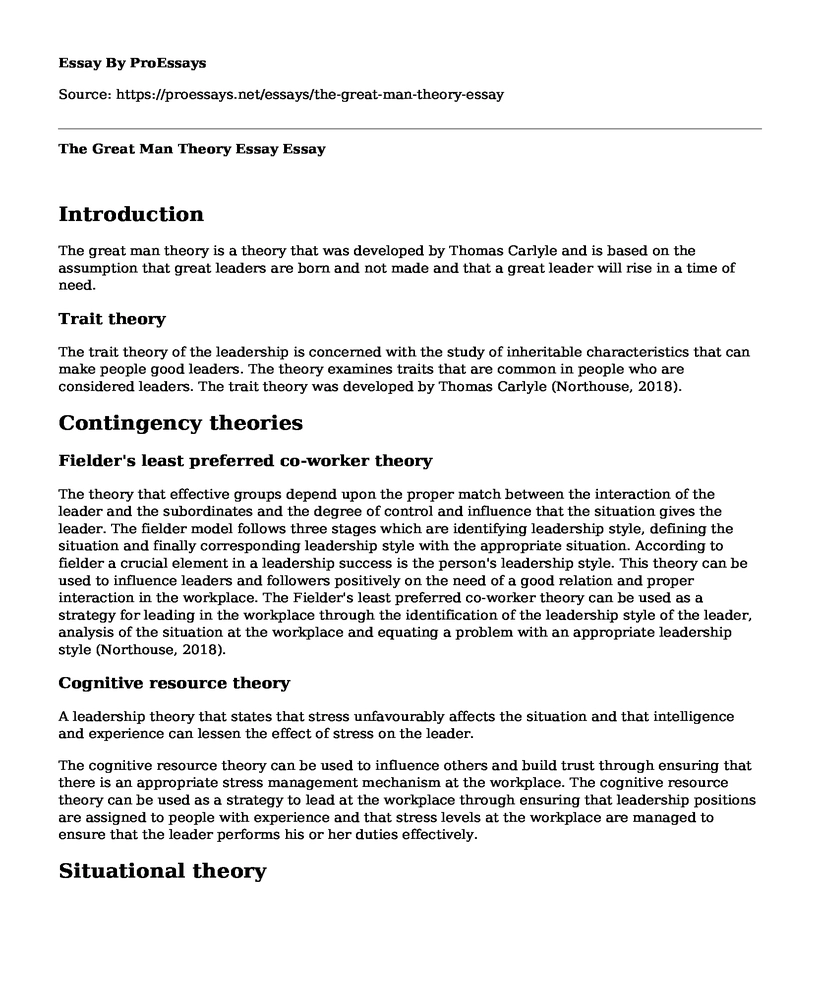Introduction
The great man theory is a theory that was developed by Thomas Carlyle and is based on the assumption that great leaders are born and not made and that a great leader will rise in a time of need.
Trait theory
The trait theory of the leadership is concerned with the study of inheritable characteristics that can make people good leaders. The theory examines traits that are common in people who are considered leaders. The trait theory was developed by Thomas Carlyle (Northouse, 2018).
Contingency theories
Fielder's least preferred co-worker theory
The theory that effective groups depend upon the proper match between the interaction of the leader and the subordinates and the degree of control and influence that the situation gives the leader. The fielder model follows three stages which are identifying leadership style, defining the situation and finally corresponding leadership style with the appropriate situation. According to fielder a crucial element in a leadership success is the person's leadership style. This theory can be used to influence leaders and followers positively on the need of a good relation and proper interaction in the workplace. The Fielder's least preferred co-worker theory can be used as a strategy for leading in the workplace through the identification of the leadership style of the leader, analysis of the situation at the workplace and equating a problem with an appropriate leadership style (Northouse, 2018).
Cognitive resource theory
A leadership theory that states that stress unfavourably affects the situation and that intelligence and experience can lessen the effect of stress on the leader.
The cognitive resource theory can be used to influence others and build trust through ensuring that there is an appropriate stress management mechanism at the workplace. The cognitive resource theory can be used as a strategy to lead at the workplace through ensuring that leadership positions are assigned to people with experience and that stress levels at the workplace are managed to ensure that the leader performs his or her duties effectively.
Situational theory
Hersey and Blanchard's situational theory
A model of leadership developed by Hersey and Blanchard that depends on the follower's readiness and effectiveness. This readiness is regarding response and acceptance or rejection of the leader. Hersey and Blanchard point out specific leader behaviours in which the most significant one depended on the follower's ability and motivation. The second leader behaviour is that if followers are not able and unwilling to do a task the leader should provide specific and clear directives, also, the leader should demonstrate that they are task-oriented, and be supportive and participatory in the task all which will influence the effectiveness of the follower (Northouse, 2018).
The Heresy and Blanchard's situational theory of leadership can be used to influence others and build trust in the workplace through the leader presenting and offering qualities that will be accepted by the followers; this is significant in ensuring that the followers are positively responsive to the leader's directives.
House's path-goal theory
The theory that a leader's behaviour is acceptable to follower's as long as they see the behaviour as a basis for instantaneous or coming gratification. The leader avails information and resources that enable the followers to achieve their goals and also ensure that the follower's goals are in line with organization's goals.
Leader's participation model
Founded by Vroom and Yetton, the leader's participation model is a leadership theory that provides a set of rules to determine the form and amount of participation required of a leader in different situations. The leader's decision making action is as significant as the decision.
The leader's participation model can employ in influencing and building trust in the workplace through the interaction of the leader and followers, the interactions of the leader and the follower through the leaders participation ensures that the leader understands the followers, participation and inclusion in the tasks of the organization is integral in ensuring that there is a good understanding between the leader and the follower in the workplace (Brower et al, 2000).
References
Brower, H. H., Schoorman, F. D., & Tan, H. H. (2000). A model of relational leadership: The integration of trust and leader-member exchange. The Leadership Quarterly, 11(2), 227-250.
Northouse, P. G. (2018). Leadership: Theory and practice. Sage publications.
Cite this page
The Great Man Theory Essay. (2022, May 09). Retrieved from https://proessays.net/essays/the-great-man-theory-essay
If you are the original author of this essay and no longer wish to have it published on the ProEssays website, please click below to request its removal:
- Communication in the Organizational Environment
- Stages of Change Management Essay Example
- Cultural Elements and the Implementation of Change Essay Example
- Essay on Student Affairs: Broadening Functional Areas for Student Success
- Essay Example on Women in Evangelism and Faith-Based Leadership: A Theological Discourse
- Free Paper Example on Balanced Scorecard Strategies for Global Competitiveness
- Social Innovation - Report Example







